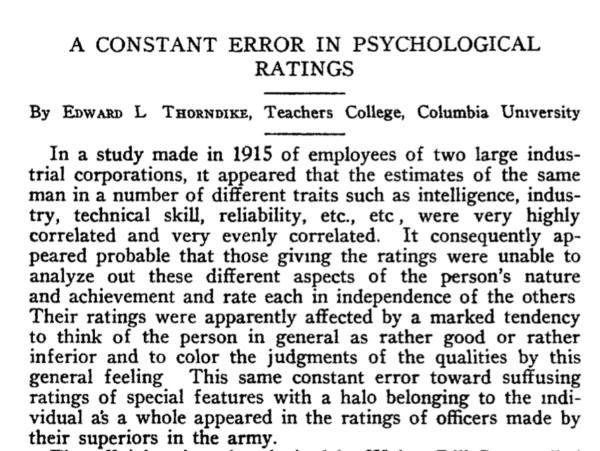I Guess You’re Here Because You’ve Heard About the ‘Halo and Horn Effect’ and You’d Like to Know More?
I’ll answer your questions on this mental model called the ‘Halo and Horn’ that can cloud our judgement.
This model is all about being aware of our biases. Our prejudices. It is about knowing that we made decisions based on assumptions. You’ve probably heard of the phrases ‘ASS U ME’ – If you assume you make an ass out of you and me. Or that we need to ‘question everything’. I disagree with both.
The parts I do agree with are that we need to be careful of our assumptions and to question more. The halo and horn effect is about understanding the assumptions and questioning those because without understanding some of our assumptions/prejudices/biases we might make the wrong decision about a person, a project, or a way forward.
First discovered in 1915 by psychologist Edward L. Thorndike when analysing officers’ evaluations of their soldiers, he discovered that our first impressions dictate our future actions. Thorndike called it the ‘Halo effect’, or the ‘Halo Error’ and described it as a tendency for positive impressions of a person, company, brand or product in one area to positively influence one’s opinion or feelings in other areas.
His example was if you noticed that a person in a photograph was attractive, well-groomed, and properly attired, you would assume that the person in the photograph was a good person based upon the rules of that individual’s social concept.

What is the Halo and Horn Effect? And What is an Example?
A cognitive bias. A mental shortcut. The halo effect is about the good and the horn effect is about the bad. For example, attractive people are thought to be more intelligent and higher-weight person people are thought to be lazy. Neither is true and yet this is an example of:
The halo effect – attractive people are thought to be more intelligent.
The horn effect – higher-weight person people are thought to be lazy.

Click on the image above for a high resolution version.
Our first impression of a person may lead to us having one or the other impression. An impression that stays with us throughout our relationship with that person. Rarely changing. It’s like we always view that person or that project through that lens. This is why first impressions have become so popular because we have increasingly become aware of how important they are.
The halo effect – a positive first impression that leads us to treat someone favourably.
The horn effect – a positive first impression that leads us to treat someone less favourably.
Why is the Halo and Horn Effect Dangerous for HR Managers?
For HR Managers it is essential that this mental model is understood for recruitment, disciplinaries, and performance. HR managers are often the recruiters and the holders of best practices for recruitment and should set examples as people leaders for others to follow. When recruiting people we might allow our halo effect to prejudice our decisions.
For example, when meeting a new person that person might be very good at building rapport and do so by finding a piece of common ground. This common ground would then influence the decision as to whether they would be offered a position. The halo effect.
For example, if the interviewee is late by a few minutes this might cause the halo effect. However, the interviewee performed in the interview, the answer was always going to be no.
How to Overcome This Bias?
As with most things, firstly knowing that it exists is half the battle. By reading this article you will have already increased your knowledge of this topic and from here on in might recollect it when you are making an important decision.
For those interviewing people, it is good to write down your bias, as a reminder of what might be the halo or horn effect. This will further help you to be very aware of it before you decide. Plus, using the STAR method for interviewing will help to keep you grounded on the candidate’s strengths, ability to do the job, and fit with the company culture.

For review/appraisals the halo/horn effect can be something that happens that day, and so making sure that the appraisal is not a once-per-year event, but a monthly event will ensure that there is less bias introduced when you are assessing someone’s appraisal. Keeping notes of those regular appraisals will help you to review that team member with less bias each time, by looking back on what you have written.
Using problem-solving techniques will apply more left-brain logic to your decision-making, which will help to avoid biases. Tools like the PRO tool for estimating numbers, or Edward De Bon’s OPV tool, will help to provide a cold logic that will push out any prejudices that you might have about a person, a project or a decision.
A good phrase to keep in mind is that a good idea is good even if it is proposed by the village idiot, whereas a bad idea is still a bad idea even if it is proposed by the company CEO.
How to Achieve Behavioural Change by Knowing This Halo and Horn Bias
Here at MBM, we are experts at achieving real behavioural change because we believe that ‘information without application is just entertainment. In other words, reading the negotiation position top tip above is useful, but only if you use it. Otherwise, it’s just information.
Stephen Covey suggested that in order to retain more of what we learn we need to tell someone else. By sharing what we have learnt with someone else it means that we had to of digested the information, and turned it into our own words. By doing this we learned it better, and we did this because we wanted to look credible when we shared it. I.e. We understood what we were sharing, rather than simply regurgitating what we had learnt.
Action: Share with someone what you learnt above. Or in your HR team meeting share what you have learnt by asking the team to identify biases that they had with previous




